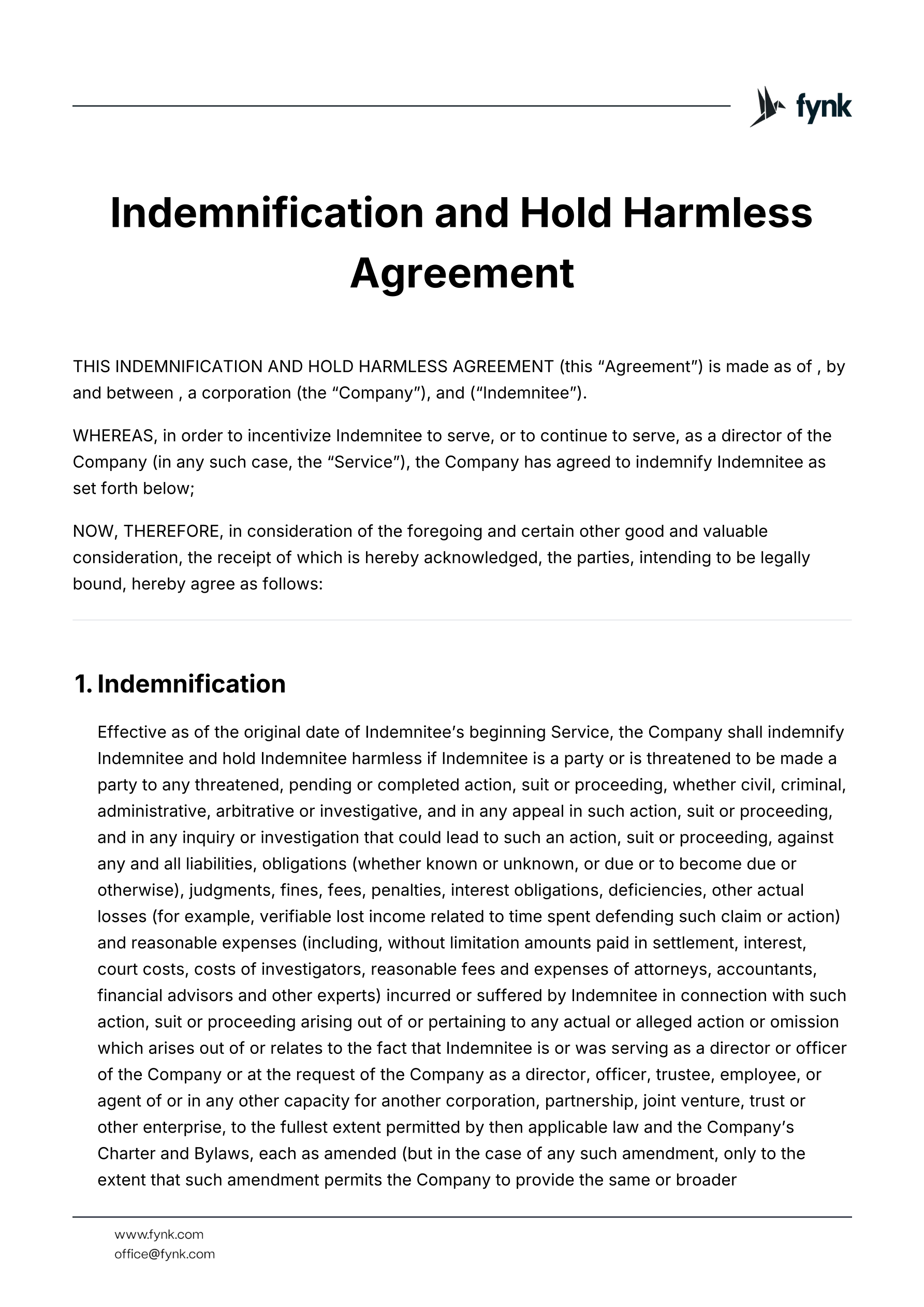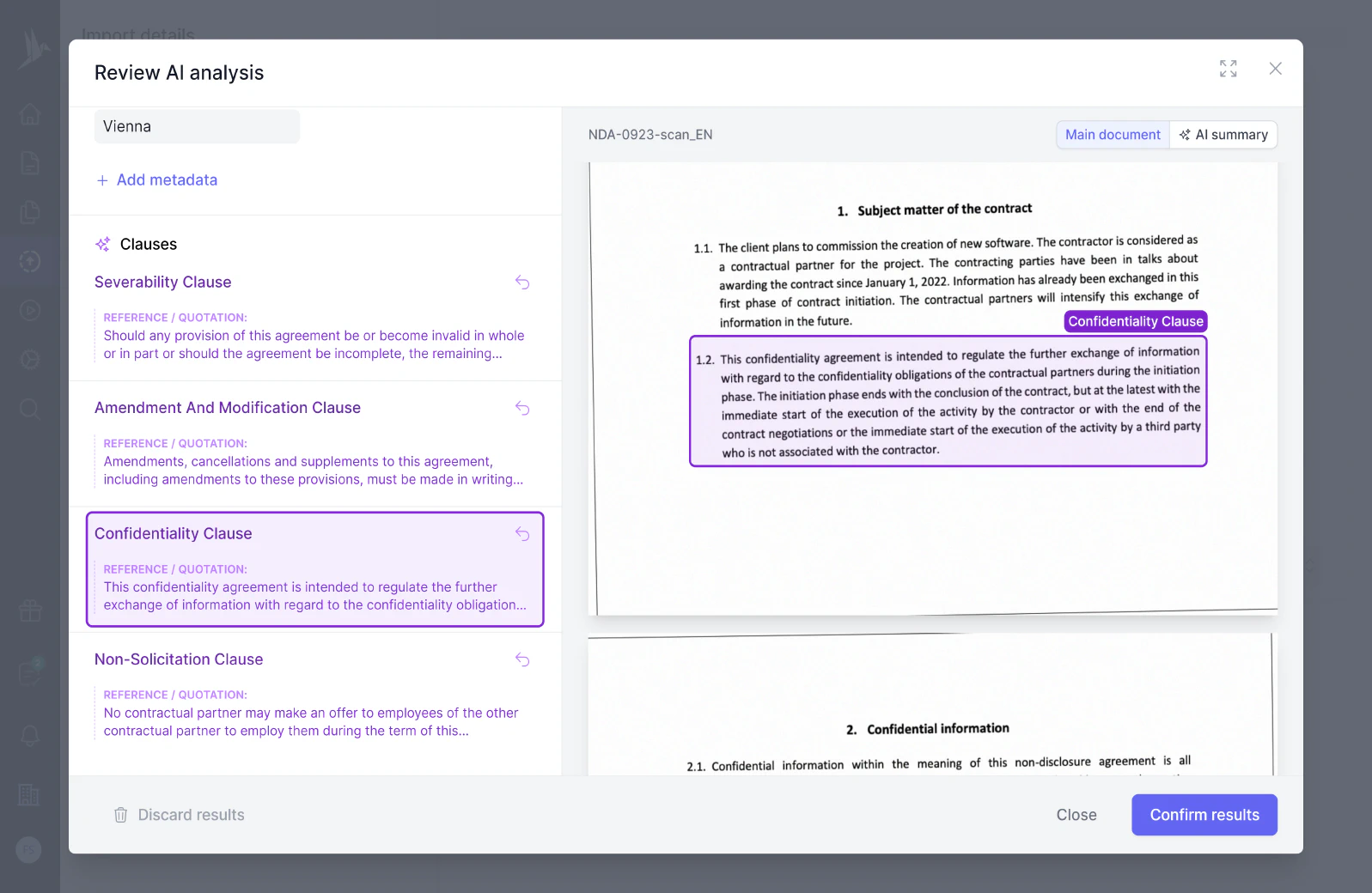
Indemnification and Hold Harmless Agreement Template
A template for companies to indemnify directors and officers against claims arising from their service, with clear terms on scope and payment timing.
A release of liability clause is a contractual provision where one party agrees to waive their right to hold the other party legally responsible for any potential claims or damages. This clause is often used to protect businesses or individuals from future lawsuits or legal claims related to the agreed-upon activities or services.
Release of Liability. Except with respect to all obligations set forth in the Lease that survive the termination of the Lease, including, without limitation, Tenant’s indemnity obligations, and except as otherwise provided in this Agreement, including, without limitation, Tenant's obligation to pay the Termination Payment pursuant to Section 4 above, and conditioned on the performance by the parties of the provisions of this Agreement, effective as of the Termination Date: (a)the parties shall be fully and unconditionally released and discharged from their respective obligations arising from or in connection with the provisions of the Lease; and (b)this Agreement shall fully and finally settle all demands, charges, claims, accounts or causes of action of any nature, including, without limitation, both known and unknown claims and causes of action that may arise out of or in connection with the obligations of the parties under the Lease. Each of the parties expressly waives the provisions of California Civil Code Section 1542, which provides: "A GENERAL RELEASE DOES NOT EXTEND TO CLAIMS THAT THE CREDITOR OR RELEASING PARTY DOES NOT KNOW OR SUSPECT TO EXIST IN HIS OR HER FAVOR AT THE TIME OF EXECUTING THE RELEASE AND THAT, IF KNOWN BY HIM OR HER WOULD HAVE MATERIALLY AFFECTED HIS OR HER SETTLEMENT WITH THE DEBTOR OR RELEASED PARTY." Each party acknowledges that it has received the advice of legal counsel with respect to the aforementioned waiver and understands the terms thereof.
Release of Liability is a form provided to an Employee upon Layoff. Unless the Participating Employee executes and does not revoke the Release of Liability, the Participating Employee forfeits all Awards.
If all or any portion of the benefits under the redundancy or layoff plan are contingent on the Employee’s signing a Release of Liability or covenant not to compete or both, the Termination shall not be considered as a “Layoff” for purposes of the Program unless the Employee executes and does not revoke a Release of Liability, a covenant not to compete, or both, acceptable to the Company, under the terms of the layoff or redundancy plan.
This release of liability shall exclude claims to enforce or protect the rights and duties created by this Agreement.
In such circumstances, and subject to the Participant executing a general release of liability against the Company which is not revoked, the Severance Plan provides the following payments and benefits to the Participants: • a lump sum payment in an amount equal to six (6) months of such Participant’s annual base salary; and • continued healthcare coverage under the Company’s health benefits then in effect applicable to the Participant for a period of six (6) months.
Release of Liability for Claims. (a)In consideration of Executive’s receipt of the Severance Benefits, Executive hereby releases, discharges and acquits the Company, and its direct and indirect subsidiaries, and each of the foregoing entities’ respective past, present and future subsidiaries, affiliates, stockholders, members, partners, directors, officers, managers, employees, agents, attorneys, heirs, predecessors, successors and representatives in their personal and representative capacities, as well as all employee benefit plans maintained by the Company or any of its subsidiaries or other affiliates and all fiduciaries and administrators of any such plans, in their personal and representative capacities (collectively, the “Company Parties”), from liability for, and Executive hereby waives, any claims, damages, or causes of action related to Executive’s employment with any Company Party or the termination of such employment existing on or prior to the date on which Executive signs this Release (the “Signing Date”), including (i) any alleged violation through such date of: (A) any federal, state or local anti-discrimination or anti-retaliation law, including the Age Discrimination in Employment Act of 1967 (including as amended by the Older Workers Benefit Protection Act), Title VII of the Civil Rights Act of 1964, the Civil Rights Act of 1991, Sections 1981 through 1988 of Title 42 of the United States Code, and the Americans with Disabilities Act of 1990; (B) the Employee Retirement Income Security Act of 1974 (“ERISA”); (C) the Immigration Reform Control Act; (D) the National Labor Relations Act; (E) the Occupational Safety and Health Act; (F) the Family and Medical Leave Act of 1993; (G) any federal, state or local wage and hour law; (H) any other local, state or federal law, regulation, ordinance or orders which may have afforded any legal or equitable causes of action of any nature; or (I) any public policy, contract, tort, or common law claim or claim for defamation, emotional distress, fraud or misrepresentation of any kind; (ii) any allegation for costs, fees, or other expenses including attorneys’ fees incurred in, or with respect to, a Released Claim; (iii) any and all rights, benefits, or claims Executive may have under any employment contract, incentive or compensation plan or agreement or under any other benefit, plan, program or practice; and (iv) any claim for compensation, damages or benefits of any kind not expressly set forth in this Release (collectively, the “Released Claims”). Notwithstanding the foregoing or any other term of this Release, in no event shall the Released Claims include (1) any claims for base salary earned in the pay period in which the Separation Date occurred, (2) any claim for employee benefits that Executive may be entitled to under the Company’s employee benefit plans as of the Separation Date, (3) any claim for reimbursement for expenses that remain unreimbursed as of the Separation Date (subject to the Company's expense reimbursement policies as then in effect), (4) any claim for the applicable Severance Benefits, (5) any claim that first arises after the Signing Date, including any claim with respect to Equity Awards or under any award agreement relating Executive’s equity ownership in the Company or any other Company Party that survives the Separation Date, (6) any claim to vested benefits under an employee benefit plan governed by ERISA.
Customers shall be required to sign a waiver and release of liability in a form approved by LICENSOR as often as deemed necessary by LICENSOR. Until notified by LICENSOR of a change in the form of waiver and release of liability, LICENSEE shall require Customers to sign the form attached hereto as Attachment B to Exhibit E: Form of Waiver and Release of Liability.
WAIVER AND RELEASE OF LIABILITY I understand and acknowledge that Drywave Technologies, USA, Inc. is licensing facilities (“Facilities”) from Fitness International, LLC to perform touchless hydro massage services utilizing heated jets of water. In consideration of being permitted to make use of and/or have access to the Facilities, I do hereby, on behalf of myself and on behalf of my heirs, successors and assigns, release and forever discharge Fitness International, LLC, its affiliates, and their respective successors, related entities, directors, officers, employees, and agents (collectively, “Releasees”) from, and hereby waive and release, any and all claims, demands, actions, and causes of action whatsoever arising out of or in any way related to any loss, damage, or injury, including death, that may be sustained by me in, on, upon, in connection with or while making use of the Facilities, regardless of whether any such loss, damage, or injury is caused by the active or passive negligence of the Releasees or otherwise and regardless of whether any such liability arises in tort, contract, strict liability or otherwise, to the fullest extent allowed by law.
Release of Liability. As of the Termination Date, Tenant releases and exculpates Landlord from any liability arising from the Lease with respect to the Premises. Tenant acknowledges that this release and waiver are an essential and material term of this Agreement, without which Landlord would not become a party to this Agreement.
Release of Liability for Claims. (a) For good and valuable consideration, including the consideration set forth in Section 2 (and any portion thereof), Executive hereby forever releases, discharges and acquits the Company, each other member of the Company Group (as defined in the Employment Agreement) and each other Company affiliate, and each of the foregoing entities’ respective predecessors, successors, equityholders, officers, directors, managers, members, partners, employees, agents, representatives, and other affiliated persons, and the Company’s and its affiliates’ benefit plans (and the fiduciaries and trustees of such plans) (each a “Released Party” and, collectively, the “Released Parties”), from liability for, and Executive hereby waives, any and all claims, damages, or causes of action of any kind related to or arising from Executive’s ownership of any interest in the Company or any other Released Party, Executive’s employment or engagement with any Released Party, the termination of such employment or engagement, and any other acts or omissions related to any matter occurring on or prior to the date that Executive executes this Agreement, including (i) any alleged violation through such time of: (A) any federal, state or local anti-discrimination or anti-retaliation law, regulation or ordinance, including the Age Discrimination in Employment Act of 1967 (including as amended by the Older Workers Benefit Protection Act), Title VII of the Civil Rights Act of 1964, the Civil Rights Act of 1991, Sections 1981 through 1988 of Title 42 of the United States Code and the Americans with Disabilities Act of 1990, as amended; (B) the Employee Retirement Income Security Act of 1974 (“ERISA”); (C) the Immigration Reform Control Act; (D) the Sarbanes-Oxley Act of 2002 and the Dodd-Frank Wall Street Reform and Consumer Protection Act; (E) the Occupational Safety and Health Act; (F) the Family and Medical Leave Act of 1993; (G) the Arizona Employment Protection Act, the Arizona Civil Rights Act, the Arizona Occupational Health and Safety Act, and the Arizona Medical Marijuana Act; (H) any federal, state or local wage and hour law; (I) any other local, state or federal law, regulation or ordinance; or (J) any public policy, contract, tort, or common law claim, including any claim for defamation, emotional distress, fraud or misrepresentation of any kind, promissory estoppel, breach of any implied duty of good faith and fair dealing, breach of implied or express contract, breach of fiduciary duty or wrongful discharge; (ii) any allegation for costs, fees, or other expenses including attorneys’ fees incurred in or with respect to a Released Claim; (iii) other than with respect to the Bonus Shares, the Accelerated RSU Shares, the Accelerated Option and the Non-Employee Director Option, any and all rights, benefits or claims Executive may have under any employment contract or other agreement (including the Employment Agreement, Option Award, Sign-On Equity, RSU Award or Performance Option (each as defined in the Employment Agreement)), incentive compensation plan or equity-based plan with any Released Party (including the Equity Plan (as defined in the Employment Agreement)) or to any ownership interest in any Released Party; (iv) any claim, whether direct or derivative, arising from, or relating to, Executive’s status as a holder of any shares or interests in any Released Party; and (v) any claim for compensation or benefits of any kind not expressly set forth in this Agreement (collectively, the “Released Claims”). This Agreement is not intended to indicate that any such claims exist or that, if they do exist, they are meritorious. Rather, Executive is simply agreeing that, in exchange for any consideration received by Executive pursuant to Section 2, any and all potential claims of this nature that Executive may have against the Released Parties, regardless of whether they actually exist, are expressly settled, compromised and waived. THIS RELEASE INCLUDES MATTERS ATTRIBUTABLE TO THE SOLE OR PARTIAL NEGLIGENCE (WHETHER GROSS OR SIMPLE) OR OTHER FAULT, INCLUDING STRICT LIABILITY, OF ANY OF THE RELEASED PARTIES.
A “Release of Liability” is a legal document in which one party agrees not to hold another party responsible for any potential legal claims or damages. Essentially, it is a way to waive the right to sue for potential injuries or losses that may occur from a particular activity or transaction. It can be used to protect individuals, businesses, or organizations from legal liability.
A Release of Liability should be used in situations where there is a risk of injury or damage, and one party wants to ensure they are not legally responsible for any adverse outcomes. Common scenarios include:
When writing a Release of Liability, it is important to ensure that the document is clear, concise, and covers all potential liabilities. Here are steps to create one:
Identify the Parties Involved: Clearly state the names of the parties who agree to the release and those who are being released from liability.
Detail the Activity or Transaction: Describe the specific event, activity, or transaction for which the release of liability is being granted.
Explain the Risks: List the potential risks involved in the activity or transaction, ensuring that the party granting the release is aware of possible dangers.
Include Legal Language: Use language that unambiguously states that the party granting the release waives their rights to sue or claim damages.
Add any Necessary Legal Clauses: Include any clauses that might be needed, such as indemnification, severability, or jurisdiction clauses.
Signature and Date: Ensure that all parties involved sign and date the document to make it legally binding.
Release of Liability
I, [Name of Releaser], hereby release and discharge [Name of Releasee], from any and all liability, claims, demands, or causes of action that may hereafter have for injuries or damages arising out of my participation in the [Activity], including but not limited to losses caused by the negligence of the released parties, or other individuals or parties involved in this activity.
I acknowledge that I am aware of the inherent risks involved in [Activity] and I voluntarily assume responsibility for any injuries sustained by me as a result of participating in this activity.
Signed: [Releaser’s Signature]
Date: [Date]
Contracts that often contain a Release of Liability include:
Keep in mind that the enforceability of a Release of Liability can vary depending on jurisdiction, and it’s often advisable to consult legal counsel when drafting or signing one.
These templates contain the clause you just read about.

A template for companies to indemnify directors and officers against claims arising from their service, with clear terms on scope and payment timing.

A performance consent and release form template that grants rights to record, broadcast, and promote live performances.

A comprehensive sponsorship agreement template outlining rights, benefits, fees, and obligations between a professional sports team and a sponsor.
Dive deeper into the world of clauses and learn more about these other clauses that are used in real contracts.
The "Release of Obligations" clause frees one or both parties from certain duties or liabilities defined in the contract once specific conditions are met or after a certain event occurs. This clause ensures that obligations are concluded, allowing the parties to move forward without further responsibilities under those specific terms.
A Release of Security Interest clause involves the relinquishment of a lender's claim on a borrower's collateral. This occurs when the borrower fulfills their obligations under a loan agreement, thereby freeing their assets from legal encumbrance.
The reletting clause allows a landlord to re-rent a property if the current tenant vacates before the lease term ends, typically to mitigate financial loss due to vacancy. This clause often requires the landlord to make reasonable efforts to find a new tenant and may hold the original tenant responsible for any shortfall in rent until a new lease is secured.
Try our AI contract analysis and extract important clauses and information from existing contracts.
< <
Fill out the form and we will get in touch with you to give you a personal, customized demo of fynk.
Greetings!
I'm Markus, co-founder of fynk. After you've submitted the form, I'll swiftly get in touch with you.
Also, right after you submit your details, you can pick a time that works best for you for our meeting.

